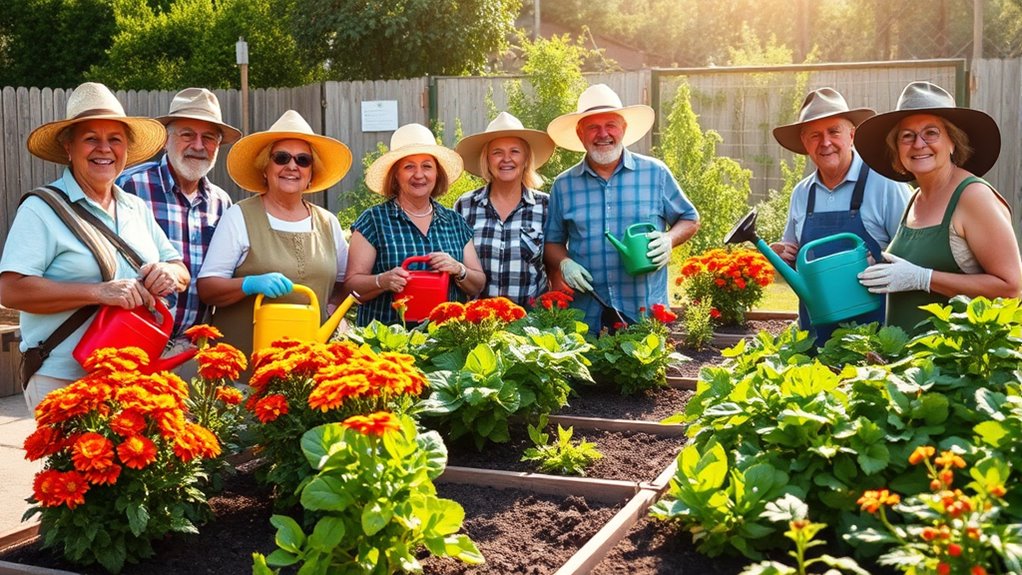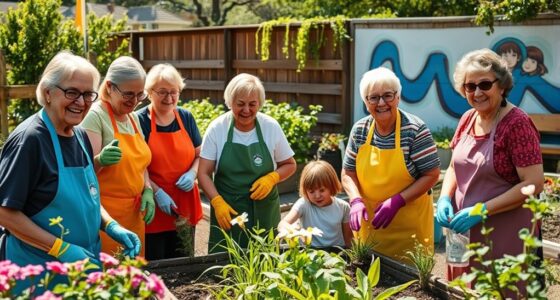To start a senior gardening club in your community, first assess what interests and safety needs seniors have by engaging with them and local groups. Plan accessible garden layouts with raised beds and easy paths, and recruit enthusiastic volunteers for various roles. Secure supplies through fundraising or donations and promote participation with fun activities. Pay attention to sustainability by maintaining clear communication, building a sense of ownership, and diversifying funding sources—keep exploring for detailed steps to build a thriving garden club.
Key Takeaways
- Engage seniors and local organizations to assess gardening interests, safety needs, and preferred activities.
- Design an accessible garden layout with raised beds, wide pathways, and adaptive tools for safety.
- Recruit volunteers, assign roles early, and establish a consistent schedule to promote participation.
- Secure resources through fundraising, donations, and community partnerships to support supplies and tools.
- Foster ongoing engagement by organizing fun activities, recognizing efforts, and encouraging member ownership.
Assessing Community Needs and Interests
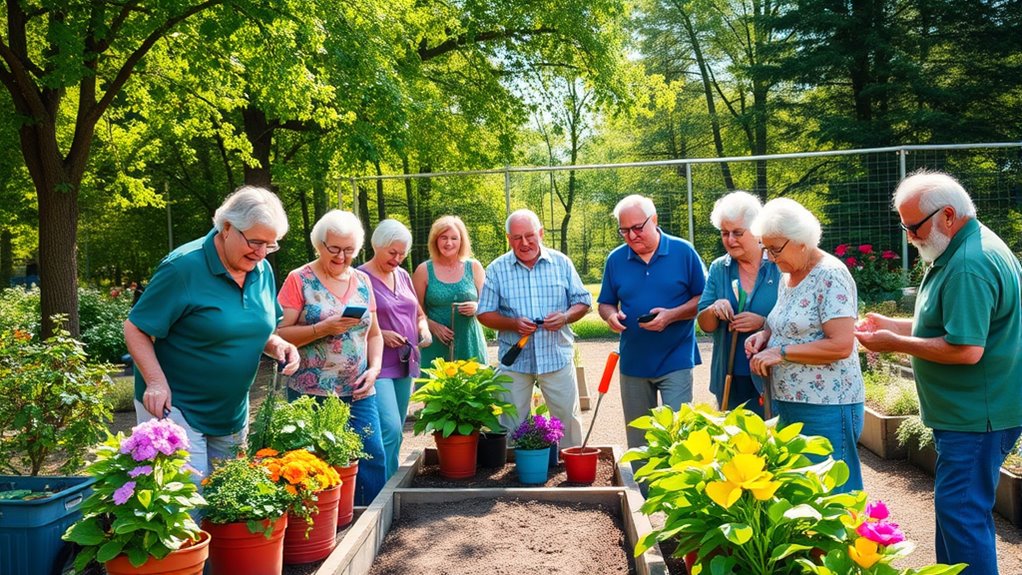
Before launching a senior gardening club, understanding what community members want and need is vital. Start by talking to seniors and local organizations to learn their gardening interests and safety concerns. Guaranteeing garden safety is a top priority, so ask about any mobility or health issues that might affect participation. This helps you design accessible activities and select suitable tools. Additionally, gauge interest in volunteering—some seniors may want to help but need specific roles or support. Engaging community members early creates a sense of ownership and makes sure the club meets their needs. Exploring remote hackathons can also provide innovative ideas for virtual gardening activities or resources. By evaluating these interests and safety considerations upfront, you set a strong foundation for a successful, inclusive gardening group that encourages participation and volunteer recruitment.
Planning and Organizing Your Gardening Club
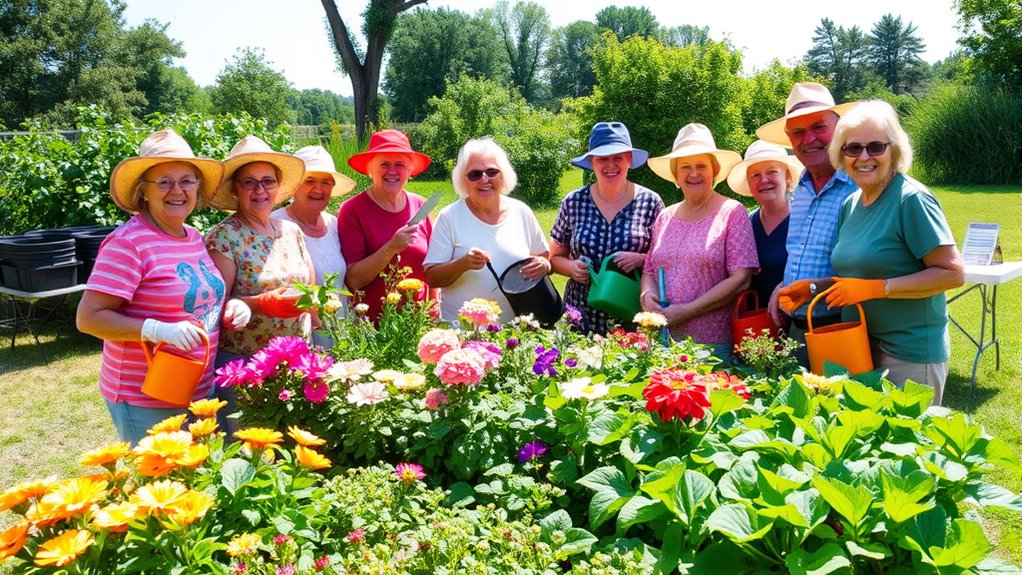
How do you guarantee your senior gardening club runs smoothly and fulfills its members’ needs? Start by planning a functional garden layout that’s accessible and safe for all participants. Consider raised beds, wide pathways, and ergonomic tools to accommodate varying mobility levels. Volunteer recruitment is essential; seek enthusiastic members who can share responsibilities like planting, watering, and maintenance. Assign roles early to keep everyone engaged and ensure tasks are evenly distributed. Establish a clear schedule for meetings and gardening sessions, and create a simple organizational structure. Communicate regularly to gather feedback and adapt plans as needed. Incorporating adaptive tools can enhance accessibility and ensure all members can participate comfortably. By thoughtfully planning your garden layout and actively recruiting volunteers, you’ll create an organized, welcoming environment that encourages participation and nurtures a sense of community.
Securing Resources and Supplies
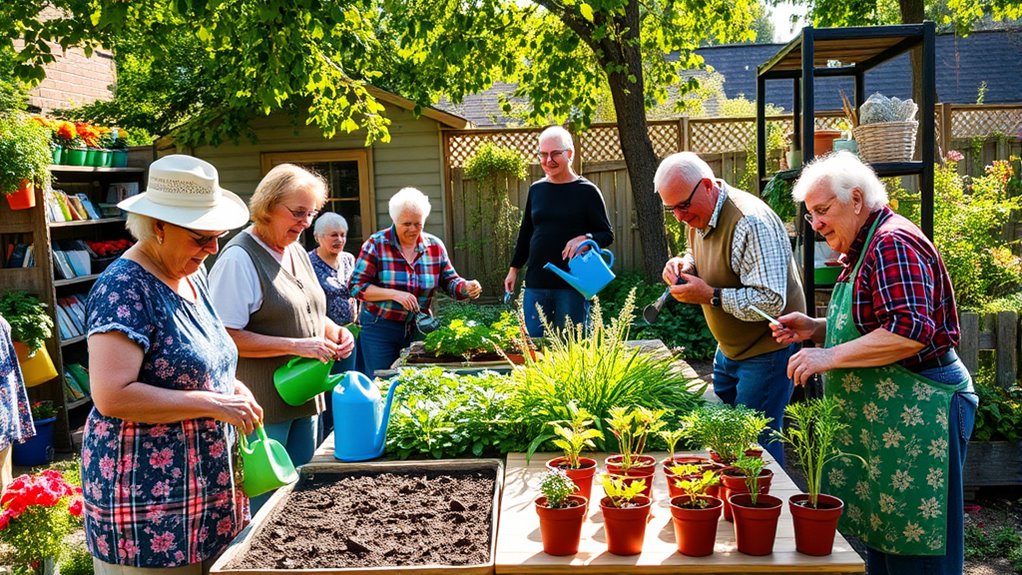
Securing the right resources and supplies is key to keeping your senior gardening club thriving. You’ll need tools, soil, seeds, and watering equipment. To cover costs, explore fundraising strategies like bake sales or donation sources such as local businesses and community members. Building a list of potential donation sources helps guarantee ongoing support for your club. Use the table below to organize your resource needs and potential fundraisers:
| Supplies Needed | Fundraising Strategies |
|---|---|
| Gardening tools | Local business sponsorships |
| Soil & seeds | Community garage sales |
| Watering cans | Fundraising events |
Staying organized with this plan ensures your club remains well-stocked and financially supported. Incorporating essential oils into your health routine can also promote well-being among members.
Promoting Participation and Engagement
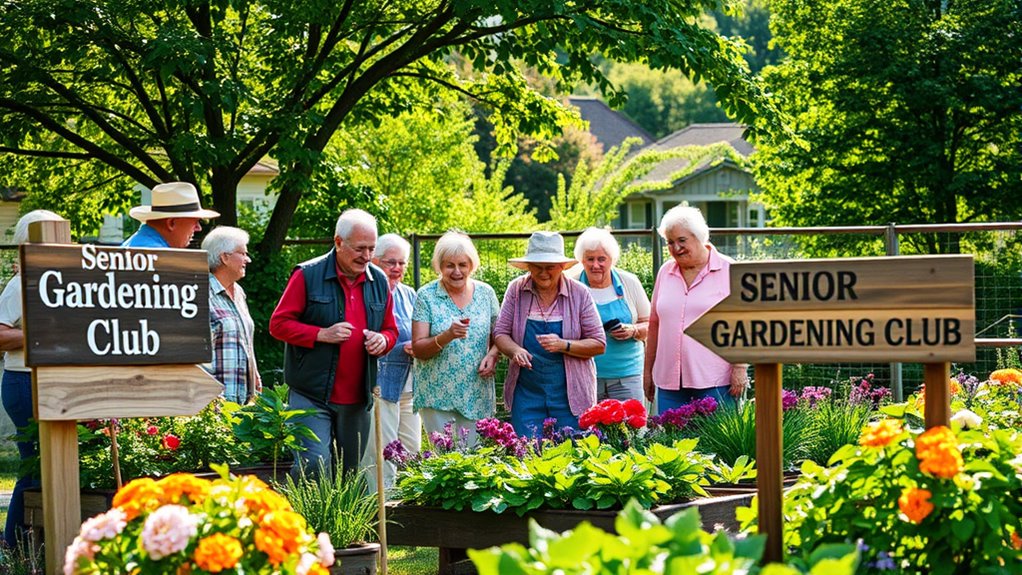
Ready to get everyone involved? To boost participation, create inviting activities that appeal to all members. Encourage planting pet-friendly plants, so members can enjoy gardening without worries about safety. Emphasize gardening safety by providing clear instructions and safe tools, ensuring everyone feels comfortable and confident. Use engaging prompts like themed planting days or flower swaps to keep interest high. Highlight the benefits of gardening, such as fresh air and social connection, to motivate participation. Recognize everyone’s efforts with small rewards or notes of appreciation. Make sure to listen to members’ ideas and preferences, fostering a sense of ownership. When people feel valued and safe, they’re more likely to stay engaged and excited about the club. Incorporating gardening culture into activities can deepen members’ connection to the hobby and community.
Sustaining the Club and Fostering Growth
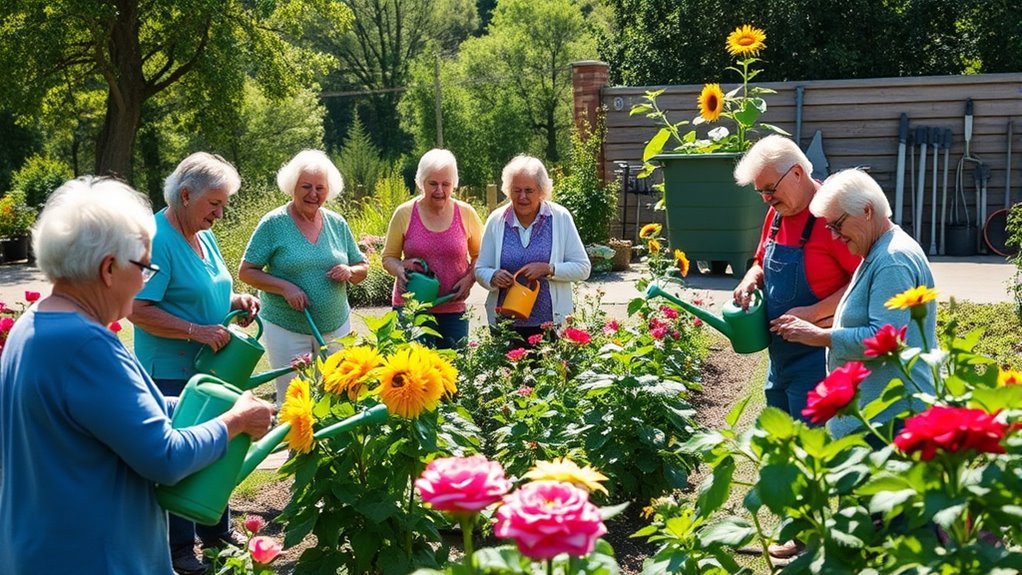
Building a strong foundation for your gardening club guarantees it remains lively and inviting over time. To sustain growth, focus on effective volunteer coordination by assigning clear roles and encouraging member participation. This keeps members engaged and sharing responsibilities. Additionally, develop diverse funding strategies, such as seeking local grants, organizing fundraisers, or requesting donations from the community. Regularly communicating your club’s progress and successes also helps maintain enthusiasm and attract new members. Consider creating a simple budget plan to manage expenses and ensure funds are allocated wisely. By fostering a sense of ownership among members and securing reliable funding, your club will thrive and adapt, creating a lasting green space that benefits everyone.
Frequently Asked Questions
How Do I Recruit Volunteers for the Gardening Club?
To recruit volunteers for your gardening club, focus on effective community outreach by sharing your enthusiasm and goals. You can use flyers, social media, and local events to spread the word. Personal invitations work well, so talk to neighbors and senior centers. Highlight the benefits of volunteering, like social connection and fresh produce. Keep it friendly and welcoming to encourage participation and build a strong, engaged gardening community.
What Safety Precautions Should Be Considered for Senior Gardeners?
When considering garden safety, you should prioritize preventing falls, avoiding strains, and ensuring proper hydration. You should also assess mobility aids to support seniors, making pathways clear and even, and providing sturdy chairs or benches. Regularly check tools and equipment to prevent injuries. Educate members about safe gardening practices, encourage wearing gloves and hats, and remind everyone to listen to their bodies. These precautions help create a safe, enjoyable gardening experience.
How Can I Incorporate Accessibility Features Into the Garden Design?
To incorporate accessibility features into your garden design, you should add raised beds that reduce the need for bending and make planting easier. Guarantee pathways are wide and smooth, creating accessible routes for wheelchairs or walkers. Use non-slip materials and clear signage. Think about seating areas for rest and easy-to-reach plants. These features make the garden welcoming and usable for everyone, especially senior gardeners with mobility challenges.
What Are Effective Ways to Fund Ongoing Club Activities?
Did you know that 65% of successful community projects rely on diverse funding sources? To fund your club’s ongoing activities, consider securing donor sponsorships from local businesses or organizations. Additionally, hosting engaging fundraising events like plant sales or garden tours can boost income. These strategies not only provide financial support but also strengthen community bonds, making your gardening club sustainable and thriving over time.
How Can I Partner With Local Organizations to Support the Club?
You can build community partnerships by reaching out to local organizations like nurseries, senior centers, and garden clubs. Offer resource sharing, such as garden tools, plants, or educational workshops, to foster collaboration. Attend community events to network and promote your club’s benefits. Volunteering and joint projects strengthen relationships, ensuring ongoing support. By actively engaging with local groups, you create a strong foundation for your club’s growth and sustainability.
Conclusion
Starting a senior gardening club is like planting a seed that blossoms into lifelong friendships and joy. By evaluating interests, organizing with care, and encouraging participation, you create a thriving community. With a little nurturing and enthusiasm, your club will grow strong and vibrant, providing endless moments of sunshine and shade alike. Remember, every garden needs patience and love—so dig in and watch your community flourish with the beauty of shared passions.
